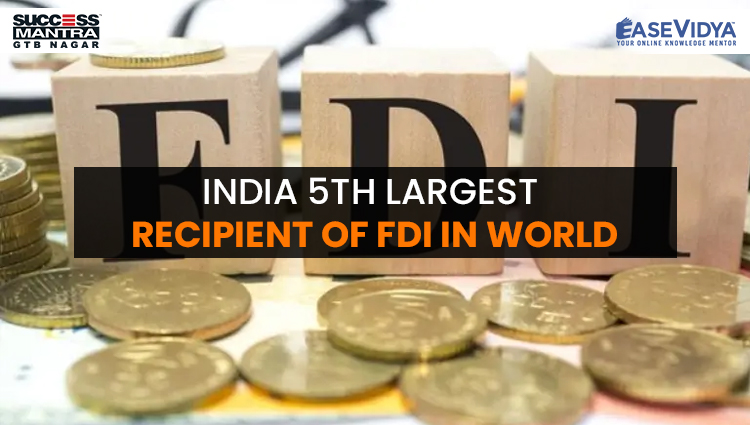
INDIA 5TH LARGEST RECIPIENT OF FDI IN WORLD
INDIA 5TH LARGEST RECIPIENT OF FDI IN WORLD

India received USD 64 billion in Foreign Direct Investment in 2020, as per World Investment Report 2021 by the UN Conference on Trade and Development (UNCTAD) that was released on June 21, 2021. This makes India the fifth-largest recipient of inflows in the world. The UN report though stated that the COVID-19 second wave weighs heavily on the country's overall economic activities but its strong fundamentals provide "optimism" for the medium term.
UN REPORT ON GLOBAL FDI FLOWS
The World Investment Report 2021 noted that the global FDI flows have been severely hit by the pandemic and they plunged by 35 percent in 2020 to USD 1 trillion from USD 1.5 trillion in 2019. The report stated that the lockdowns imposed around the world due to COVID-19 slowed down the existing investment projects and the prospects of a recession led multinational enterprises (MNEs) to reassess new projects.
UN REPORT ON INDIA'S FDI FLOWS

The report stated that in India, FDI inflow increased by 27 percent to USD 64 billion in 2020 from USD 51 billion in 2019. This makes India the fifth-largest FDI recipient in the world. The inflow was boosted by acquisitions in the information and communication technology (ICT) industry. Further, it noted that the pandemic boosted demand for digital infrastructure and services globally. This led to higher values of greenfield FDI project announcements targeting the ICT industry. Such announcements rose by more than 22 percent to USD 81 billion. Some of the major project announcements in the ICT industry included a USD 2.8 billion investment by online retail giant Amazon in ICT infrastructure in India. However, the second wave of the COVID-19 outbreak in India in April 2021 has heavily impacted the country's overall economic activities, leading to a large contraction in 2021. The outbreak severely hit main investment destinations such as Maharashtra, which is home to one of the biggest automotive manufacturing clusters and Karnataka, which is home to the Bengaluru tech hub. These states like most others in India were under a strict lockdown since April 2021.
UN REPORT ON FDI IN SOUTH ASIA
As per the UN report, FDI in South Asia grew by 20 percent to USD 71 billion in 2021, driven mainly by strong mergers and acquisitions in India. The report noted that robust investment through acquisitions in ICT (software and hardware) and construction bolstered FDI amid India's struggle to contain the virus outbreak. The cross-border mergers and acquisitions surged by 83 percent to USD 27 billion during this time with major deals involving ICT, health, infrastructure and energy.
Some of the larger transactions included:
- Acquisition of Jio Platforms by Jaadhu, a subsidiary of Facebook for USD 5.7 billion
- Tower Infrastructure Trust acquisition by Brookfield Infrastructure (Canada) and GIC (Singapore) for USD 3.7 billion
- Sale of L&T India's electrical and automation division for USD 2.1 billion. Unilever India's merger with GlaxoSmithKline Consumer Healthcare India, subsidiary of GSK United Kingdom) for USD 4.6 billion
The FDI outflows from South Asia fell by 12 percent to USD 12 billion, driven by investment drop from India. India was ranked 18 among the world's top 20 economies for FDI outflows. India recorded outflows worth USD 12 billion in 2020 as compared to USD 13 billion in 2019. The investments from India are expected to stabilise in 2021, supported by the resumption of free trade agreement (FTA) talks with the European Union (EU) and its strong investment in Africa.
UNCERTAINTY TO REMAIN SAYS THE REPORT
The UN report has cautioned that while Asia has managed to deal with the COVID-19 pandemic relatively well, the second wave of COVID-19 shows that there are still many uncertainties. A wider resurgence of COVID-19 in Asia could significantly lower global FDI in 2021, given that region's significant contribution to the total. Further, the FDI inflows to Asia grew by 4 percent to USD 535 billion in 2020, making it the only region to record growth. This has increased Asia's share of global inflows to 54 percent. China saw FDI increase by 6 percent to USD 149 billion in 2020. China and India are some of the largest economies in developing Asia to have recorded FDI growth in 2020, as the rest recorded a contraction. The FDI inflows in Asia are expected to further increase in 2021, surpassing the other developing regions with a projected growth of 5-10 percent.
WHAT WILL PUSH FDI GROWTH IN ASIA?

The report states that the signs of trade and industrial production recovering in the second half of 2020 provide a strong foundation for FDI growth in 2021. However, it notes that there are substantial downside risks for the many economies in the region that struggle to contain successive waves of COVID-19 cases and where the fiscal capacity for recovery spending is limited. " The economies in East and South-East Asia and India are predicted to continue to attract foreign investment in high-tech industries, given their market size and their advanced digital and technology ecosystem.
FDI PROSPECTS IN INDIA IN 2021
India's strong fundamentals provide optimism for the medium term, as per the report. FDI to India has been on a long-term growth trend and its market size is expected to attract more market-seeking investments. The investment into the ICT industry is also expected to keep up its upward growth. While India's export-related manufacturing, which is a priority investment sector, will take longer to recover, government facilitation is expected to play a major role in helping it. Further, India's Production Linkage Incentive scheme, which is designed to attract the manufacturing and export-oriented investments in priority industries including automotive and electronics, is expected to drive a rebound of investment in manufacturing.
TEST YOURSELF
Q.1 India received USD 64 billion in Foreign Direct Investment in 2020, as per the report of which of the following organisations which also makes India the fifth-largest recipient of inflows in the world?
- United Nations Industrial Development Organization (UNIDO)
- UN Conference on Trade and Development (UNCTAD): ANSWER
- World Trade Organization (WTO)
- None of the above
Q.2 Consider the given statements & state which of the following is/are incorrect in the reference to the above mentioned passage?
- The report stated that in India, FDI inflow increased by 27 percent to USD 64 billion in 2020 from USD 51 billion in 2019 which makes India the fifth-largest FDI recipient in the world.
- The pandemic boosted demand for digital infrastructure and services globally which led to higher values of greenfield FDI project announcements targeting the ICT industry.
- Only I follows
- Only II follows
- Both I & II follows
- None of the above: ANSWER
Q.3 A surge in foreign capital inflow in India would lead to _______?
- Purchase of foreign exchange by central bank in order to prevent appreciation of rupee: ANSWER
- Sale of foreign exchange by the central bank in order to prevent depreciation of rupee
- Purchase of foreign exchange by central bank in order to prevent depreciation of rupee
- Sale of foreign exchange by the central bank in order to prevent appreciation of rupee
Q.4 The foreign direct investment which means when a company takes controlling ownership in a business entity in another country includes ……….?
- Intellectual Property
- Human Resource
- Tangible Good: ANSWER
- Intangible Goods
Q.5 Which of the following statements is/are correct in the context of the China's becoming the top trading partner of India?
- China becomes the largest commercial partner displacing the European Union bilateral trade at USD 75.9 billion amid reduced demand for goods in the middle of the Covid-19 pandemic.
- Total imports from China at USD 58.7 billion were more than India’s combined purchases from the USA and the UAE.
- Only I is correct
- Only II is correct: ANSWER
- Both I & II are correct
- None of the above













0 Comment